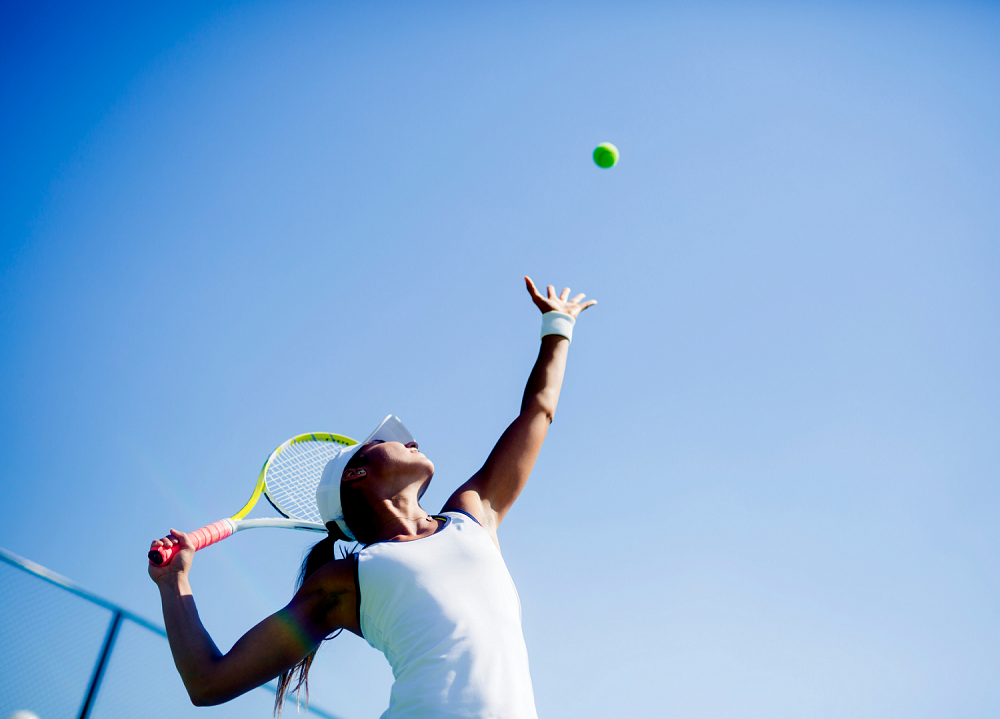Dr Natasha Beach
Consultant in Sports and Musculoskeletal Medicine
Specialist expertise: Sports Injuries, Paediatric Injuries, Sports and Exercise Medicine, Orthopaedics, Sports Medicine, Concussion, Frozen Shoulder.
It’s that time of year when the weather begins to improve, Wimbledon is approaching and trying to book a public tennis court becomes the survival of the fittest. It’s also when elbow and shoulder injuries become more commonplace. Dr Natasha Beach, Sports Medicine Consultant at OneWelbeck Orthopaedics, looks at the common injuries we see from racket sports, why they might have occurred in the first place, and what we can do about them.

Why injuries occur is probably the main question a consultant will want to get an answer to when someone presents with an injury – namely to try and prevent the same issue occurring in the future.
Sometimes the cause is obvious such as a trip or slip leading to a fall, but other times it is more subtle and a combination of seemingly minor things. For example:
This is indeed a myth. While tennis elbow does occur in tennis players, it also happens in other sports such as squash, HIIT classes and those who see themselves as relatively inactive.
Neck or elbow issues can often present as shoulder pain, whereas shoulder issues are often felt in the upper arm or down to the elbow.
This is true in part – rest does allow the body to try and heal itself. However, without broaching the issues that lead to the injury in the first place, it will more than likely come back.
The rotator cuff is made up of 4 tendons that allow the shoulder to move in all directions. These can become tendinopathic – i.e., weak, and irritable, or tear. Tears can come on suddenly with no warning or can be on a background of a few weeks/months of lower pain levels. The supraspinatus tendon is the most frequently injured tendon, and this presents with a general ache in the shoulder down into the upper arm. The pain is often made worse by lifting the arm, such as taking the racket back in preparation for a serve or a ground stroke.
Investigation of choice: Ultrasound, sometimes followed by an X-ray or MRI depending on the ultrasound findings.
Management: Rehabilitation (e.g., physiotherapy, osteopathy etc), pain relief (including tablets or steroid injections), shockwave therapy, addressing the reasons why they issue occurred, and (rarely) surgery.
The labrum is a ring of cartilage that circles the socket of the shoulder (the glenoid). This cartilage can tear suddenly because of a fall, or if the shoulder dislocates however this also can be torn because of repeated use e.g., serving. This can feel like a general ache in the shoulder, but may also feel like something clicking or catching as the shoulder is moved
Investigation of choice: MRI (sometimes with the addition of an injection of contrast – known as an arthrogram)
Management: Rehabilitation (e.g., physiotherapy, osteopathy etc), pain relief (including tablets or steroid injections) and (rarely) surgery.
The shoulder is a joint with a wide range of movement, which is restricted by ligaments, muscles, and tendons to prevent it going too far. Occasionally the joint has more movement than it should. This can occur because of a prior injury (e.g., dislocation), be due to a more general hypermobility, or because of ligamental laxity from to stretching over time. Like a SLAP tear. This can give a feeling of something catching or moving in the joint, and a generalised discomfort which can be specific to certain positions, or after activity.
Investigation of choice: This is often a diagnosis made on examination alone, however imaging may be required to exclude other causes or to review the ligaments after a fall etc.
Management: Rehabilitation (e.g., physiotherapy, osteopathy etc), pain relief (including tablets or steroid injections), looking at technique and (rarely) surgery.
This is where the tendons that extend the wrist become tendinopathic as they reach their attachment on the outside of the elbow. Pain is often felt on taking the racket back on the forehand, or the contact point on the backhand
Investigation of choice: Ultrasound, sometimes followed by an X-ray or MRI depending on the Ultrasound findings
Management: Rehabilitation (e.g., physiotherapy, osteopathy etc), pain relief (including tablets or steroid injections), Shockwave therapy, addressing the reasons why they issue occurred, and (rarely) surgery.
You can read more information about tennis elbow in this news article.
This is very similar to tennis elbow however the pain is located on the inside of the elbow where the wrist flexors attach. Pain is often felt on taking the racket back on the backhand, or the contact point on the forehand.
This ligament is found on the inside of the elbow and is put under pressure with certain grips – e.g., full Weston or during the take back and acceleration phase of the serve.
Investigation of choice: Ultrasound, sometimes followed by an X-ray or MRI depending on the ultrasound findings
Management: Rehabilitation (e.g., physiotherapy, osteopathy etc), pain relief (including tablets or steroid injections), addressing the reasons why they issue occurred, and (rarely) surgery.
These are the most common injuries we see in our sports medicine clinics, however there are other types of injuries.
If you have any questions or have an injury you would like to assess, please feel free to get in contact: natasha.beach@onewelbeck.com
Dr Natasha Beach is a Sports and Exercise Medicine Consultant, UK Pro League Medical Director (and slightly obsessive tennis player)
Here at OneWelbeck, we have a team of orthopaedic specialists, state of the art facilities and diagnostics, and highly competitive financial packages for self-funding patients as well as those with private health care.
Orthopaedics